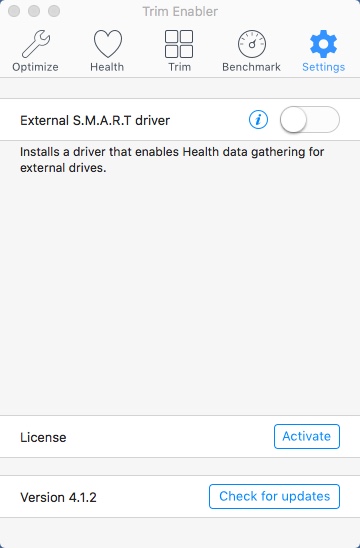

- Cindori’s trim enabler how to#
- Cindori’s trim enabler software#
- Cindori’s trim enabler mac#
- Cindori’s trim enabler windows#
If Trim Enabler 3.4.2 cannot be quit normally, you can select the app in Activity Monitor, click the large red “Quit Process” button in the left corner and click Force Quit button in the pop-up dialog. To deactivate an app, right click its icon in the dock and select Quit option (or choose Trim Enabler 3.4.2 > Quit Trim Enabler 3.4.2 on the Menu bar).Īlso, you can access the Activity Monitor (located in /Applications/Utilities/ folder), and see if there is any background process pertaining to the app.
Cindori’s trim enabler mac#
Prior to the removal of Trim Enabler 3.4.2, you should first log into your Mac with an administrator account, and turn Trim Enabler 3.4.2 off if it is running.
Cindori’s trim enabler how to#
In this post we will discuss the following questions: (1) What is the correct way to uninstall Trim Enabler 3.4.2? (2) How to ensure all its accompanying components are removed safely? And (3) is there a shortcut for both Mac novices and experts to take to accomplish Trim Enabler 3.4.2 removal effortlessly? Conventional Steps to Uninstall Trim Enabler 3.4.2 for Mac Even for the experienced users, they may also get lost when trying to uninstall a problematic, stubborn or even malicious application. In the latter case it is quite necessary to clean out those junk files from your Mac for complete removal.įor some novice users, they may have no idea how to remove Trim Enabler 3.4.2 in a proper way. These vestiges can be very small in size, thus leaving them alone may not affect your Mac performance, yet they can also be a large chunks of useless files that occupy a large portion of your hard drive space.
Cindori’s trim enabler software#
However, a fact is often neglected that, even the stand-alone software may might still leave its configuration and preferences files on multiple system directories after you carry out a basic uninstall. Generally speaking, most Mac applications are separate bundles that contain the executable and any associated resources for the app, and therefore users can easily remove any unwanted software (if they are installed properly) from their Macs. In normal cases Mac users just need to simply drag and drop the target app to the Trash and then empty the Trash to perform the standard uninstallation.
Cindori’s trim enabler windows#
Uninstalling applications in macOS/Mac OS X is quite different from that in Windows operating system. Things you should know about Mac app removal: How to uninstall Trim Enabler 3.4.2 on Mac computer? If you encounter problem when trying to delete Trim Enabler 3.4.2 as well as its associated components, read through this removal tutorial and learn about how to perfectly remove any unwanted applications on your Mac. I experienced this firsthand when my SanDisk SSD started slowing down as it got older before enabling TRIM on it.Trim Enabler 3.4.2 Removal Tutorial - How to Easily Uninstall Trim Enabler 3.4.2 Once your computer restarts, check System Report again to see if TRIM Support changed to Yes.įinally, TRIM does matter, even for modern SSDs with sophisticated garbage collection. Just open Terminal and type “sudo trimforce enable”. If it is listed but says “No”, you can try turning TRIM on by using the trimforce command in terminal. If TRIM Support is not listed, your enclosure most likely does not support TRIM. In order to check if your enclosure supports TRIM, you’ll want to go to Apple > About This Mac > System Report > Hardware > SATA/SATA Express > and look for “TRIM Support” under the enclosure specs. I used the trimforce command in terminal to enable it. Most Thunderbolt enclosures should support TRIM, and I currently have TRIM enabled on a SanDisk Extreme SSD in an Akitio Thunderbolt 2 enclosure.

Firewire supposedly supports TRIM, but I haven't tested it. All five of the USB 3 enclosures / docks I have support it. The vast majority of USB enclosures do not support TRIM, but allegedly there are some that support it such as the JMS 578 USB bridge controller (source: ). (I have sources but Stack Exchange won't let me post more than 2 links)Ĭontrary to many of the comments here, the interface DOES matter. Then in OS X 10.10.4, Apple introduced a “trimforce” command which enabled TRIM on 3rd party SSDs without turning off kext signing. Later, OS X 10.10 (Yosemite) introduced a security requirement called kext signing which prevented TRIM Enabler from working without completely turning off kext signing. To get around that restriction, software such as Cindori's TRIM Enabler allowed TRIM to be used on 3rd party SSDs. I realize this question is over 4 years old, but I'm adding a comment because this page was the first hit for a Google search on the subject and some of the comments are outdated whereas others were plain wrong.Īpple added native TRIM support in OS X 10.6.8 but only for Apple OEM SSDs.


 0 kommentar(er)
0 kommentar(er)
